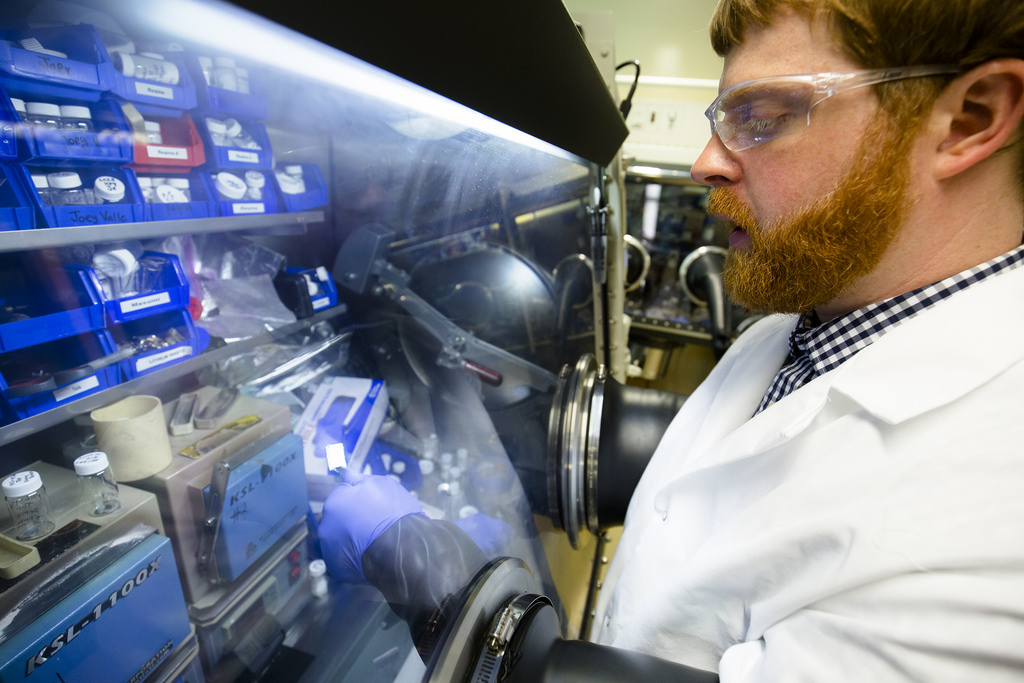
A rechargeable battery technology developed by engineers at the University of Michigan (U-M) could double the output of today's lithium-ion cells – drastically extending electric vehicle ranges and time between cell phone charges – without taking up any added space.
By using a ceramic solid-state electrolyte, the engineers were able to harness the power of lithium-metal batteries without the historic issues of poor durability and short-circuiting. The result is a roadmap to what could be the next generation of rechargeable batteries.
"This could be a game-changer – a paradigm shift in how a battery operates," said Jeff Sakamoto, a U-M associate professor of mechanical engineering, who led the work. Sakamoto and his team report their findings in a paper in the Journal of Power Sources.
In the 1980s, rechargeable lithium-metal batteries that used liquid electrolytes were considered the next big thing, penetrating the market in early portable phones. But their propensity to combust when charged led engineers in different directions. The lithium atoms that shuttle between the electrodes tended to build tree-like filaments called dendrites on the electrode surfaces, eventually shorting the battery and igniting the flammable electrolyte.
The lithium-ion battery – a more stable, but less energy-dense technology – was introduced in 1991 and quickly became the new standard. These batteries replaced lithium metal anodes with graphite anodes, which absorb the lithium and prevent dendrites from forming, but also come with performance costs.
Graphite can hold only one lithium ion for every six carbon atoms, giving it a specific capacity of approximately 350 milliampere hours per gram (mAh/g.) The lithium metal in a solid-state battery has a specific capacity of 3800mAh/g. Current lithium-ion batteries max out with a total energy density around 600 watt-hours per liter (Wh/L) at the cell level. In principal, solid-state batteries can reach 1200Wh/L.
To solve lithium-metal's combustion problem, U-M engineers created a ceramic layer that stabilizes the surface – keeping dendrites from forming and preventing fires. It allows batteries to harness the benefits of lithium metal – energy density and high-conductivity – without the dangers of fires or degradation over time.
"What we've come up with is a different approach – physically stabilizing the lithium metal surface with a ceramic," Sakamoto said. "It's not combustible. We make it at over 1800°F in air. And there's no liquid, which is what typically fuels the battery fires you see. You get rid of that fuel, you get rid of the combustion."
In earlier solid-state electrolyte tests, lithium metal grew through the ceramic electrolyte at low charging rates, causing a short circuit, much like in cells with liquid electrolytes. U-M researchers solved this problem with chemical and mechanical treatments that provide a pristine surface for lithium to plate evenly, effectively suppressing the formation of dendrites or filaments. Not only does this improve safety, it leads to a dramatic improvement in charging rates.
"Up until now, the rates at which you could plate lithium would mean you'd have to charge a lithium-metal car battery over 20 to 50 hours [for full power]," Sakamoto said. "With this breakthrough, we demonstrated we can charge the battery in three hours or less.
"We're talking a factor of 10 increase in charging speed compared to previous reports for solid-state lithium-metal batteries. We're now on par with lithium-ion cells in terms of charging rates, but with additional benefits. "
That charge/recharge process is what inevitably leads to the eventual death of a lithium-ion battery. Repeatedly exchanging ions between the cathode and anode produces visible degradation right out of the box. In testing the ceramic electrolyte, however, no visible degradation is observed after long term cycling, said Nathan Taylor, a U-M post-doctoral fellow in mechanical engineering.
"We did the same test for 22 days," he said. "The battery was just the same at the start as it was at the end. We didn't see any degradation. We aren't aware of any other bulk solid-state electrolyte performing this well for this long."
Bulk solid-state electrolytes could produce cells that are a drop-in replacement for current lithium-ion batteries and thus able to leverage existing battery manufacturing technology. With the material performance verified, the research group has now begun producing thin solid electrolyte layers required to meet solid-state capacity targets.
This story is adapted from material from the University of Michigan, with editorial changes made by Materials Today. The views expressed in this article do not necessarily represent those of Elsevier. Link to original source.





